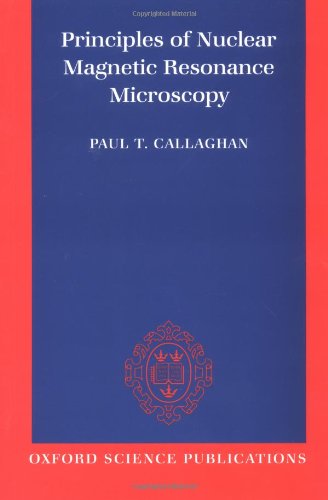Principles of Nuclear Magnetic Resonance Microscopy book download
Par ford antonio le samedi, octobre 1 2016, 23:27 - Lien permanent
Principles of Nuclear Magnetic Resonance Microscopy. Paul Callaghan

Principles.of.Nuclear.Magnetic.Resonance.Microscopy.pdf
ISBN: 0198539444,9780198539445 | 512 pages | 13 Mb

Principles of Nuclear Magnetic Resonance Microscopy Paul Callaghan
Publisher: Oxford University Press, USA
Download Free eBook:Protein NMR Spectroscopy: Principal Techniques and Applications - Free chm, pdf ebooks rapidshare download, ebook torrents bittorrent download. Callaghan, Principles of Nuclear Magnetic Resonance Microscopy (Clarendon Press, Oxford, 1993)[ Amazon][WorldCat]. According to MR principles, the lowest detection limit is 1018 spins per voxel 24. �Nuclear magnetic resonance is a key technology for determining the structure of molecules and for visualising the anatomy of living tissue and microscopic structure. An NMR technique tracks the diffusion of water molecules to obtain micron-scale structural information about a porous material. Callaghan, Principles of Nuclear Magnetic Resonance Microscopy, Clarendon, Oxford, UK, 1991. (1994) Principles of Nuclear Magnetic Resonance Microscopy, Oxford University Press. Prior to the development of three-dimensional magnetic resonance imaging (MRI), the tracking of immune cell migration was limited to microscopic analyses or tissue biopsies. It has helped revolutionise “The NMR operates under the same principles as magnetic resonance imaging (MRI, which many patients experience as part of modern medical procedures) but is powered by a superconductor and has a magnetic field 400,000 times stronger than the Earth's magnetic field. 4Center for Magnetic Resonance Research, Department of Radiology, University of Minnesota Medical School, 2021 Sixth Street SE, Minneapolis, MN 55455, USA 5Department of Electrical and Computer Engineering, University of Minnesota, 200 Union Street SE, P. In addition, the similarity between 19F and 1H ( regarding their NMR properties) is a prerequisite for a meaningful overlay between the anatomical 1H MRI with the 19F MRI of labeled cells. For instance, in 29Si NMR spectra of Au-C sample (Figure 2) four resonance lines at −96, −102, −108.3 and −113.6 ppm were identified, which correspond to Si(3Al), Si(2Al), Si(1Al) and Si(0Al) configurations, respectively [27]. He has published around 220 articles in scientific journals, as well as Principles of Nuclear Magnetic Resonance Microscopy (Oxford University Press, 1994). Rainer Kimmich, NMR Tomography, and Diffusometry, Relaxometry (Springer-Verlag, Berlin, 1997)[Amazon][WorldCat].